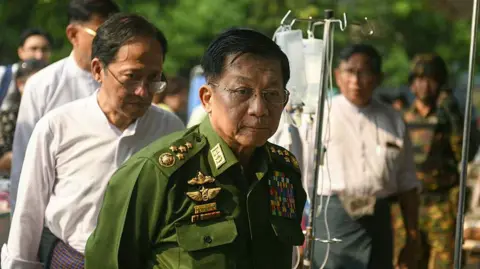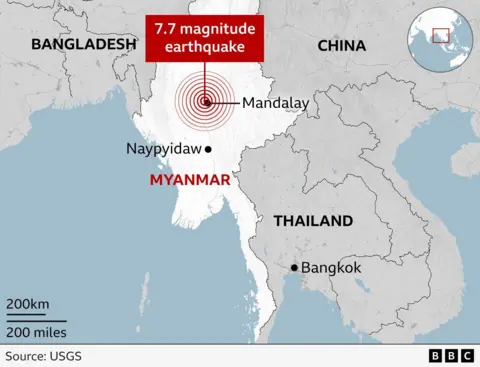After a four -year civil war, a severe food crisis and an economy in the decline, Myanmar now finds itself devastating from a strong earthquake.
On Friday, the 7.7 earthquake set the size of the city of Sagaing in central Myanmar, followed by reports of the destruction of Mandalay nearby – the second largest city in the country – as well as the capital, NiB Tao, which is more than 150 miles (241 km).
It is difficult to get information from Myanmar. The mobile devices in the affected areas have been incomplete since the earthquake hit, but tens of thousands of people also live without electricity and there is limited access to the Internet. Foreign journalists are rarely allowed to formally enter due to the lack of freedom of the press.
So, how did Myanmar get here?
The country has witnessed contracts of unrest and military rule since its independence from Britain in 1948.
In 2011, it appears to be away from this, and the free elections were held four years later Aung San Suui beat.
Democratic hopes decreased in 2021, when she and her government were overthrown through a coup led by General Min Ong Hinging.
He was accused and accused of Mrs. Suk and other members of her government, which led to allegations of widespread fraud in voting months ago, when the National Democracy Association Party won more than 80 % of the poll.
The coup led huge protests, taking thousands to the streets every day, demanding the restoration of civil rule. Civilian and army violence quickly escalated, with the army responding with a brutal force, using tear gas and rubber bullets against crowds.
Rights groups believe that hundreds of people have died and thousands were injured in the campaign.
What started at the beginning as a civil disobedience campaign, quickly developed into a widespread rebellion that includes rebel groups supporting democracy and groups-which eventually sparked a comprehensive civil war.
Four years later, violent fighting continued between the army on the one hand, and the ethnic armies and armed resistance groups on the other hand.
The army has suffered from great losses and no longer controls large parts of the country. The discontent with General Min Aung Hang has also increased among the army with the defect of more and more soldiers.
The fighting has left millions living in constant fear and insecurity – with little access to basic needs, including medical care and food, says rights groups.
More than 3.5 million people were displaced due to fighting, according to the United Nations, who also said that this number will only grow with the continued conflict.
The organization's World Food Program says that food insecurity has reached “unprecedented levels”, adding that rapid inflation has made food unpopular for many.
Earlier this week, the United Nations announced that it would reduce aid to more than a million people in Myanmar next month, noting the lack of global financing.
This comes months after the death of more than 200 people in Yagi afternoonWhich led to severe mud beads and collapses in Myanmar and left hundreds of thousands of acres of destroyed crops.
 Gety pictures
Gety picturesThere is no doubt that the earthquake on Friday will add to the suffering of the country of 50 million people.
It was hit near the city of Sagaing – the rebel stronghold. Just months ago, the heavy fighting site between the rebels and the army was, as local reports stated that the air strikes were launched, causing thousands of flight.
The earthquake, the second largest city, was wounded by the earthquake, which is home to 1.5 million people. The Mandalay area witnessed an intense fight between the resistance forces and the army.
A group of very limited information that comes out of the country indicates that the hospital in the capital Naypyidaw, where the military government sits, has turned into a “collective victims location” – the few pictures that we can see a picture of destruction, and show the escalating roads and collapsed buildings.
“Hundreds of injured people arrive … but the emergency building here also collapsed,” hospital security officials told AFP.
Junta in the country has now declared a state of emergency in multiple regions and has made a rare request for international assistance.
But it is not clear how they will respond to the earthquake while they are fighting a war under the leadership of a besieged general.





